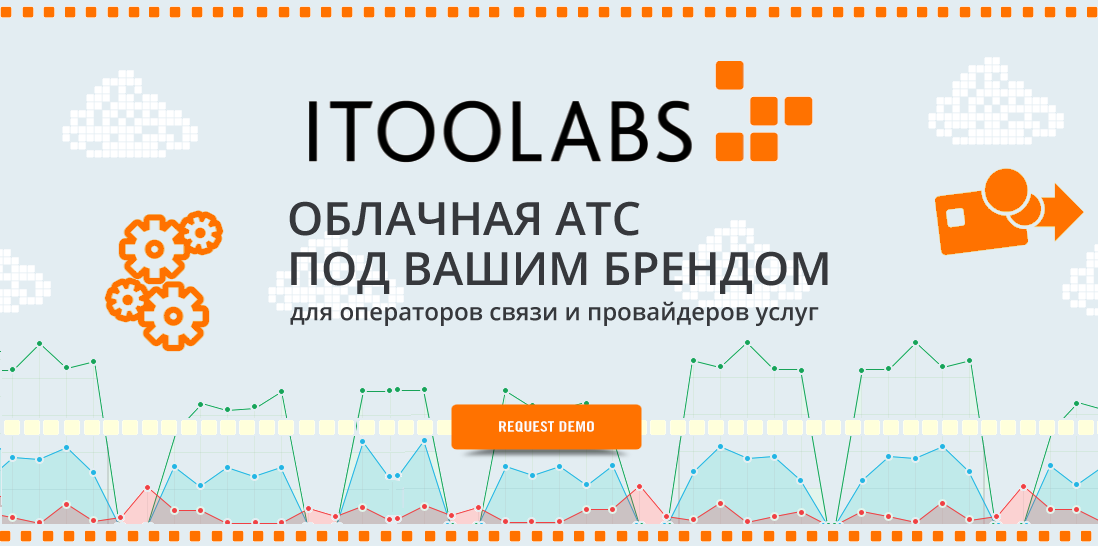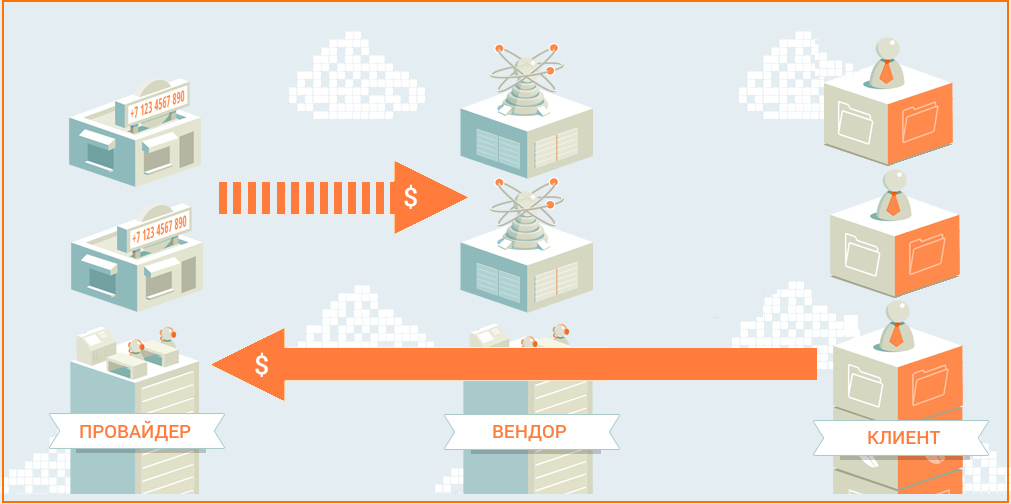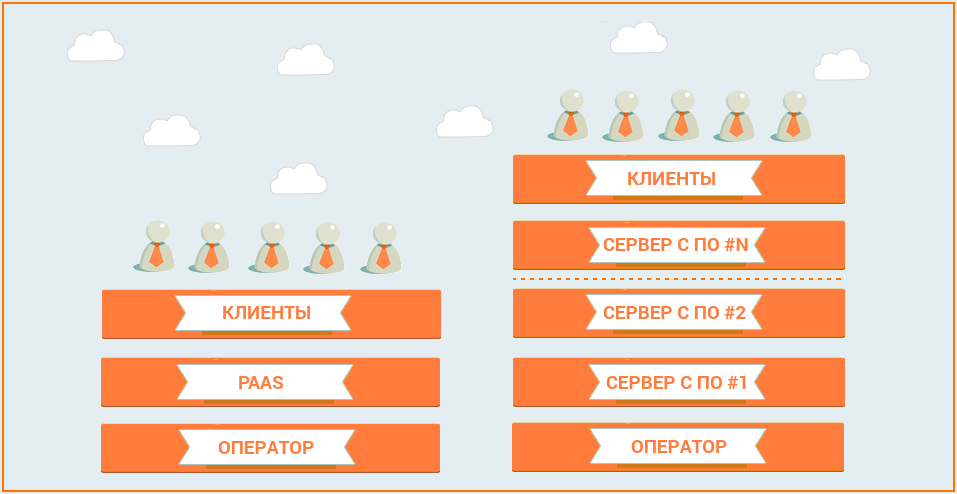PaaS vs Licenses. Four noble truths of IT infrastructure
Everything flows, everything changes, everything moves. This popular expression very accurately describes the processes occurring in modern business and especially in the telecommunications business. Most experts agree that IT market players should actively move forward, if only to stay in place. According to analysts, many telecoms tend to have a comfortable delusion: “We don’t need to hurry, we will have time to build and launch all the necessary services and platforms on our own, we are flexible and technologically advanced, there’s no reason to rush.” It was necessary to start to start new services still "yesterday". In this hub, we will share our thoughts on which way of deploying new services and platforms on the side of telecom operators is the most effective and justified.

We will deliberately leave the model of developing service platforms on our own, due to the tediousness and resource-intensiveness of such a model. We know many examples of when a service provider, having begun developing its own solution, was stuck in the phase of endless testing and launch. Historically, there are two ways to quickly launch a new VAS - buy the necessary software from a third-party developer or use the PaaS platform of one of the vendors. Our company is just one of these vendors: the White Label Cloud IP-PBX ITooLabs Communications Server is one of the successful examples of PaaS solutions for telecom operators, with more than 40 installations on sites around the world. It is this expertise that shaped our vision of which of the ways to launch new carrier services is the most optimal. We are not afraid to cause the righteous anger of the respected developers of the “boxes”, because we understand the market situation very well.
Business is always about money, so the goal of any new project is to make a profit, quickly reach profitability and minimize investment in infrastructure. Operator infrastructure is a very expensive resource and those vendors who take this into account receive a significant competitive advantage. The most understandable and technologically advanced model that allows us to offer our partners a “launch” in a short time and with minimal cost is the PaaS model. Reducing the initial investment at the service launch stage is only part of the problem, further operation and costs associated with it, is the second key factor, which largely determines the choice of vendor by the telecom operator. The cost of operating the PaaS platform can be reduced by applying revenue-sharing business model. In this case, the service provider does not pay the vendor fixed monthly payments for the lease of the cloud, but rather shares the part of the profits from the sales of the service to its customers. We use this particular business model and are convinced of the correctness of our choice. Schematically, “jealousy” looks like two dynamic cash flows directed from the client to the service provider and from the provider to the vendor.
')

In the case of purchasing a service platform as a licensed software, the above advantages are leveled. The first and main problem that arises before the operator at the stage of choosing the “right decision” is investment. We do not deny the fact that there are quite attractive “boxes”, the functionality of which meets the requirements of the market, but the cost of licenses, per user, is very high. A characteristic dilemma - “expensive, but functional” and “cheaper, but no frills” - is often solved by operators in favor of budget, which means that a strategic mistake is made at the service launch stage - the box functionality is not capable from the very beginning provide all competitive advantages.
Our vision of the unambiguous benefits of PaaS over licenses can be displayed in the form of such a comparative table:

Let's run and fix the main points.
There is also an important moment directly related to the infrastructure on which the new service lives. Infrastructure is equipment, software, SBC and nodes. Cloud PaaS is a uniform entity that fits into one square on the operator’s network topology diagram. A purchased and unwrapped “box” is a whole set of squares that resembles a staircase. Sometimes this staircase does not lead to exactly where it would be desirable, but on one of the steps you can stumble and fall painfully.

Now about the “four noble truths” from the title of the hub. We tried to make them so succinct and obvious and describe all the advantages of cloud platforms. So PaaS is:
We expect that many of the readers of this hub may not agree with everything written above. But let's abstract from the prevailing stereotypes and stop thinking that endless development, unique functionality and a dozen know-how is the right way, and the existence of a “zoo” of servers and switches is a reason to believe that the battle for the client has been won. In modern conditions, the success of the telecom business is determined by a small set of indicators: the subscriber base, the inflow, the outflow and ARPU, the concept of “monopoly” is becoming a thing of the past. Unification, efficiency, instant adherence to the conjuncture are the requirements of the time. Buying software and deploying it on your own site, you risk getting stuck in the middle of that very staircase. The market has become so dynamic that we practically have no time to play with the new functionality and relaxed monitoring of new trends. We should not observe the trends, we should follow them on the heels, and PaaS is a significant segment of the telecom business, which in the near future will crowd out other, outdated, infrastructure models.

We will deliberately leave the model of developing service platforms on our own, due to the tediousness and resource-intensiveness of such a model. We know many examples of when a service provider, having begun developing its own solution, was stuck in the phase of endless testing and launch. Historically, there are two ways to quickly launch a new VAS - buy the necessary software from a third-party developer or use the PaaS platform of one of the vendors. Our company is just one of these vendors: the White Label Cloud IP-PBX ITooLabs Communications Server is one of the successful examples of PaaS solutions for telecom operators, with more than 40 installations on sites around the world. It is this expertise that shaped our vision of which of the ways to launch new carrier services is the most optimal. We are not afraid to cause the righteous anger of the respected developers of the “boxes”, because we understand the market situation very well.
Business is always about money, so the goal of any new project is to make a profit, quickly reach profitability and minimize investment in infrastructure. Operator infrastructure is a very expensive resource and those vendors who take this into account receive a significant competitive advantage. The most understandable and technologically advanced model that allows us to offer our partners a “launch” in a short time and with minimal cost is the PaaS model. Reducing the initial investment at the service launch stage is only part of the problem, further operation and costs associated with it, is the second key factor, which largely determines the choice of vendor by the telecom operator. The cost of operating the PaaS platform can be reduced by applying revenue-sharing business model. In this case, the service provider does not pay the vendor fixed monthly payments for the lease of the cloud, but rather shares the part of the profits from the sales of the service to its customers. We use this particular business model and are convinced of the correctness of our choice. Schematically, “jealousy” looks like two dynamic cash flows directed from the client to the service provider and from the provider to the vendor.
')

In the case of purchasing a service platform as a licensed software, the above advantages are leveled. The first and main problem that arises before the operator at the stage of choosing the “right decision” is investment. We do not deny the fact that there are quite attractive “boxes”, the functionality of which meets the requirements of the market, but the cost of licenses, per user, is very high. A characteristic dilemma - “expensive, but functional” and “cheaper, but no frills” - is often solved by operators in favor of budget, which means that a strategic mistake is made at the service launch stage - the box functionality is not capable from the very beginning provide all competitive advantages.
Our vision of the unambiguous benefits of PaaS over licenses can be displayed in the form of such a comparative table:

Let's run and fix the main points.
- Launching a new PaaS service is a matter of several days, in the case of licenses, the process stretches over long weeks: software deployment and its integration with existing platforms (switches, switches, intermediate web servers) is necessary. Plus the first in favor of the clouds.
- The cloud is already deployed in a cluster and there is no need to buy server equipment, the server is the vendor’s area of responsibility, and it has already acquired and configured everything. In the case of “boxed software,” the startup process begins with the choice of hardware, which, by the way, also requires time-consuming. The second cloudy “PaaS plus”.
- It is clear that licenses cost money and need to be purchased, and you have to buy not only licenses, but often also “configuration and configuration services”. The amounts in the accounts of software developers are often scared by the number of zeros. The cost of the cloud, on the contrary, is vanishingly small. The third plus on the list.
- New software - new problems and the load on the engineering staff. The only way to reduce the load is to use an additional personnel resource, and this is also money for salaries and expenses for training. Clouds are good because you do not even know the names of those who serve these clouds. Fourth, indisputable, plus.
- Licenses tend to end. And, as a rule, they end because at the stage of implementation it was decided to buy the minimum package, because “then we will always buy more, if that”. This “later” can result in a substantial amount, since no one will sell the licenses to the operators individually, this is not an antivirus to the office. Clouds are airy and non-permanent forms, they can be scaled infinitely. Plus fifth and convincing.
- Support has always been worth the money, not even in the sense of the salary of technical specialists, but in the sense of “paying for the update”. When it comes to solutions for operators, the developer always wants money for any movement, otherwise his business model is lame. Support is the same source of revenue for the vendor as the sale of licenses. This is an axiom. Clouds are updated quietly and transparently, the appearance of a new update in most cases is an e-mail notification and no “total account” at the end of the letter. Sixth nice plus.
- The developer of the box loses interest in the partner’s business immediately after paying the bill. He got his. Further not his care. The sales manager sets the task in CRM to “call after a year” and goes to negotiate with a new potential client. The less he will be disturbed - the better. In the case of “PaaS plus“ rhubarb, ”managers will send emoticons to Skype at least once a week. Their KPI directly depends on the sales of the operator, which means that many problems are solved by a simple mouse click. The seventh and not the last plus from our list.
There is also an important moment directly related to the infrastructure on which the new service lives. Infrastructure is equipment, software, SBC and nodes. Cloud PaaS is a uniform entity that fits into one square on the operator’s network topology diagram. A purchased and unwrapped “box” is a whole set of squares that resembles a staircase. Sometimes this staircase does not lead to exactly where it would be desirable, but on one of the steps you can stumble and fall painfully.

Now about the “four noble truths” from the title of the hub. We tried to make them so succinct and obvious and describe all the advantages of cloud platforms. So PaaS is:
- convenient and efficient. In combination with “rhubarb-sharing” partner gets the most optimal business solution. The vendor takes care not only of the technical aspects of cooperation, the vendor helps to sell and ensures that the service is in demand: it monitors the market, introduces all the most requested functionality. Your profit is the vendor's profit too.
- dynamic and flexible. The service is scaled almost to infinity and this flexibility allows you to build optimal tariff plans. The operator is not limited to the fixed cost of the license and can quickly respond to changing market conditions.
- always the most advanced platform. Cloud vendor is very important your sales, this is his business. You can be sure that its programmers and marketers are working tirelessly and soon you will have the same option that your most technologically advanced competitor recently announced.
- break even. The launch of a new service will not delay the company's financial resources and can be used to develop other business lines. “Vendor-operator” cash flows arise only when a “customers-operator” cash flow appears, actual profits are distributed and the resource is not frozen. The first money, real, and not from reporting, arise instantly.
We expect that many of the readers of this hub may not agree with everything written above. But let's abstract from the prevailing stereotypes and stop thinking that endless development, unique functionality and a dozen know-how is the right way, and the existence of a “zoo” of servers and switches is a reason to believe that the battle for the client has been won. In modern conditions, the success of the telecom business is determined by a small set of indicators: the subscriber base, the inflow, the outflow and ARPU, the concept of “monopoly” is becoming a thing of the past. Unification, efficiency, instant adherence to the conjuncture are the requirements of the time. Buying software and deploying it on your own site, you risk getting stuck in the middle of that very staircase. The market has become so dynamic that we practically have no time to play with the new functionality and relaxed monitoring of new trends. We should not observe the trends, we should follow them on the heels, and PaaS is a significant segment of the telecom business, which in the near future will crowd out other, outdated, infrastructure models.
Source: https://habr.com/ru/post/271227/
All Articles